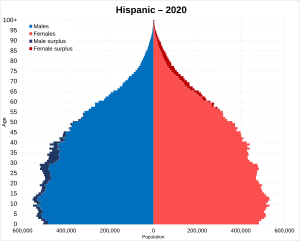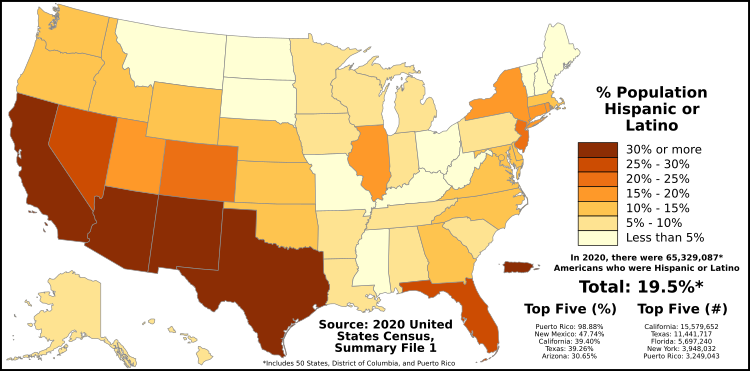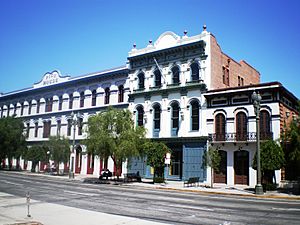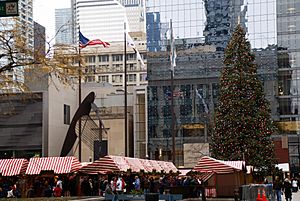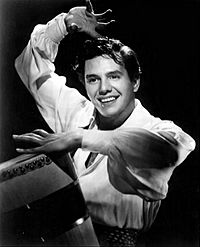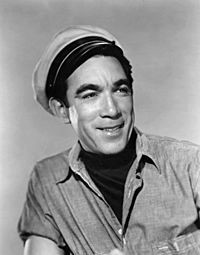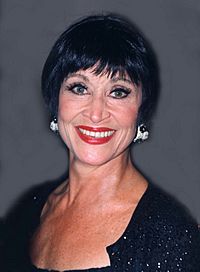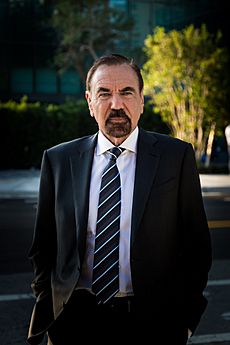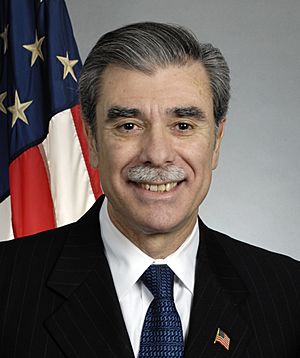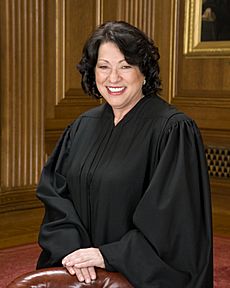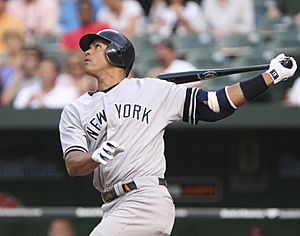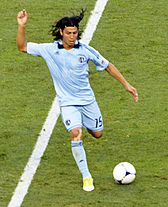Hispanic and Latino Americans facts for kids
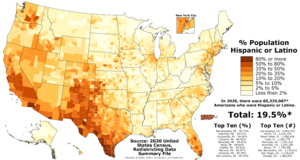
Proportion of Hispanic and Latino Americans in each county of the fifty states, the District of Columbia, and Puerto Rico as of the 2020 United States Census
|
|
| Total population | |
|---|---|
19.5% of the total US and Puerto Rico population (2020) 18.7% of the total US population (2020) |
|
| Regions with significant populations | |
|
|
| Languages | |
| Religion | |
|
|
| Related ethnic groups | |
|
Hispanic and Latino Americans are people in the United States who have roots from Spain or Latin America. This group includes anyone who identifies as Hispanic or Latino, no matter their background. In 2020, about 65.3 million Hispanics and Latinos lived in the U.S. and its territories. This means they make up about 19.5% of the total population.
Being "Hispanic" or "Latino" is about your family's origin, where they came from, or their country of birth before moving to the U.S. People who identify as Hispanic or Latino can be of any race. It's one of the main ways the U.S. Census Bureau groups people by their background. This group is very diverse, bringing together many cultures and languages. Spanish and Portuguese are the most important shared languages.
Most Hispanic and Latino Americans come from places like Mexico, Puerto Rico, Cuba, El Salvador, or the Dominican Republic. The main origin of Hispanic and Latino people changes depending on where you are in the U.S. In 2012, Hispanic Americans were the second fastest-growing ethnic group in the U.S., after Asian Americans.
People of Indigenous and Spanish descent are some of the oldest groups in what is now the United States. Spain colonized large parts of the Southwestern United States and West Coast. This included areas like California, Texas, and Florida. These lands were once part of New Spain, with its capital in Mexico City. After Mexico became independent from Spain in 1821, these territories became part of Mexico. Later, they became part of the U.S. after the Mexican–American War in 1848.
Contents
Understanding Hispanic and Latino Terms
The words "Hispanic" and "Latino" describe an ethnic group. "Hispanic" became popular in 1977. It referred to people from Spanish-speaking countries. The U.S. Census Bureau says being Hispanic is an ethnicity, not a race. So, people of any race can be Hispanic.
In a 2015 survey, most Hispanics (56%) felt their background was both racial and ethnic. Some (19%) saw it as only ethnic, and fewer (11%) as only racial. Most American Hispanics (71%) also agreed that speaking Spanish is not needed to be considered Hispanic/Latino.
Hispanic and Latino people often share language, culture, history, and traditions. The Smithsonian Institution says "Latino" includes people with Portuguese roots, like Brazilians. It also includes those from Spanish-speaking countries. The U.S. Census Bureau uses "Hispanic" and "Latino" to mean the same thing. They define them as anyone from Spain or Spanish- or Portuguese-speaking countries in the Americas.
The term "Latino" is a shorter way of saying "latinoamericano." This Spanish word means someone from Latin America. So, a Mexican American or Puerto Rican is both Hispanic and Latino. A Brazilian American is also Latino because Brazil is in Latin America and speaks Portuguese. Italian Americans are usually not considered Latino. This is because their families mostly came from Europe, not Latin America.
People in the Eastern U.S. often prefer "Hispanic." Those in the West tend to prefer "Latino."
The term Latinx has also gained some use. It uses an "x" instead of "a" or "o" to be more inclusive of all genders. This helps break away from the idea that groups of mixed or unknown gender are called "Latinos" (male form). A 2020 survey found that about 3% of Hispanics use the term. Most of them are women. Only about 23% had even heard of the term. Of those, 65% said it should not be used for their ethnic group.
Some people say that "Hispanic" and "Latino" don't fully show how diverse this group is. They include many races, national origins, and language backgrounds.
A Look at History
Early Explorers and Settlements (1500s-1600s)
Spanish explorers were among the first Europeans in what is now the U.S. Juan Ponce de León landed in Florida in 1513. He was the first confirmed European to reach the continental U.S. Over the next 30 years, the Spanish explored many areas. They reached the Appalachian Mountains and the Mississippi River. They also explored the Grand Canyon and the Great Plains.
Spanish ships sailed along the Atlantic and Pacific Coasts. From 1528 to 1536, Álvar Núñez Cabeza de Vaca traveled from Florida to California. In 1540, Hernando de Soto explored much of the present-day U.S. Also in 1540, Francisco Vásquez de Coronado led 2,000 Spaniards and Mexican natives. They traveled from Arizona into central Kansas.
In 1565, the Spanish built the first lasting European settlement. It was in St. Augustine, Florida. Spanish missionaries and colonists founded other towns. These include Santa Fe, New Mexico, El Paso, Texas, San Antonio, Los Angeles, and San Francisco.
Changes in Land (1700s-1800s)
By 1783, Spain claimed about half of the land in today's U.S. After the American Revolutionary War, the U.S. gained land from Spain and Mexico. This happened through treaties, purchases, and the Mexican–American War. The U.S. gained states like California, Texas, and Florida. Many Hispanic people already lived in these areas. New immigrants from Mexico, Central America, and South America also arrived. This was the start of a big increase in the Hispanic population.
Growth and Contributions (1900s-Today)
Hispanic immigration grew a lot in the 20th and 21st centuries. This was especially true after changes to immigration laws in 1965. During the World Wars, Hispanic Americans helped the U.S. economy. They took jobs in factories when others went to war. This is why many Hispanic Americans live in cities like Chicago and Detroit.
Hispanic Americans have made many important contributions. To honor them, President Lyndon B. Johnson started National Hispanic Heritage Week in 1968. In 1988, President Ronald Reagan made it a month-long event. It is now called National Hispanic Heritage Month. In 2004, Hispanic Americans became the largest minority group in the U.S.
Population Facts
In 2020, Hispanics made up about 19-20% of the U.S. population. This is about 62-65 million people. The U.S. Census Bureau thinks Hispanics were undercounted by about 3.3 million people.
Between 2000 and 2007, the Hispanic population grew by 28.7%. This was about four times faster than the total U.S. population. From 2005 to 2006, it grew by 3.4%. This was three and a half times faster than the national growth rate. By 2010, Hispanics were the largest minority group in 191 out of 366 major U.S. cities. Experts predict that by 2050, there will be 132.8 million Hispanic people in the U.S. This would be over 30% of the total population.
Language and Culture
Speaking Spanish
Spanish is a very important part of Hispanic culture. Many Hispanic families teach their children Spanish. They see it as a link to their family, heritage, and culture. They also believe it helps with future job opportunities. A 2013 survey showed that 95% of Hispanic adults felt it was important for future generations to speak Spanish.
Because the U.S. is close to Spanish-speaking countries, Spanish is passed down. Among second-generation Hispanics, 80% speak fluent Spanish. Among third-generation Hispanics, 40% speak fluent Spanish. Spanish is also the most popular language taught in the U.S.
Hispanics have helped bring the Spanish language back to the U.S. It was first spoken here in the 1500s. Spanish is the oldest European language in the U.S. It has been spoken continuously since 1565. Today, 90% of all Hispanics speak English. At least 78% also speak fluent Spanish. About 2.8 million non-Hispanics also speak Spanish at home.
Many Hispanics are immigrants (40%) or children/grandchildren of immigrants. This means that speaking two languages (bilingualism) is common. At home, about 69% of Hispanics over five years old speak both English and Spanish. About 22% speak only English, and 9% speak only Spanish.
Spanish Dialects in the U.S.
| Year | Number of speakers |
Percent of population |
|---|---|---|
| 1980 | 11.0 million | 5% |
| 1990 | 17.3 million | 7% |
| 2000 | 28.1 million | 10% |
| 2010 | 37.0 million | 13% |
| 2012 | 38.3 million | 13% |
| 2020* | 40.0 million | 14% |
| *-Projected; sources: | ||
The Spanish spoken in the U.S. varies by where people are from. In the Southwest, people often speak Mexican Spanish. A unique type of Spanish, called Traditional New Mexican Spanish, is spoken by descendants of early Spanish colonists in New Mexico and Colorado. It has special words and grammar.
On the East Coast, people usually speak Caribbean Spanish. This is influenced by Spanish from Cuba, the Dominican Republic, and Puerto Rico. Isleño Spanish is an old dialect spoken in Louisiana. It came from Spanish colonists in the 1700s. In other parts of the country, Mexican Spanish is generally common.
Spanglish and English Dialects
Hispanics have added many Spanish words to the English language. Younger Hispanics often use Spanglish, which mixes Spanish and English. They switch between languages easily. Spanglish is common in cities with many Hispanics, like Miami and Los Angeles.
Hispanics have also changed how English is spoken in the U.S. For example, in Miami, a unique English dialect has formed. It was developed by second and third-generation Cuban Americans. You can hear it all over the city. Famous speakers include Gloria Estefan and Enrique Iglesias.
Another English dialect is Chicano English, spoken by Chicanos and Tejanos in the Southwest. George Lopez and Selena are examples of people who speak it. New York Latino English is spoken by Puerto Ricans and other Hispanic groups in New York. Jennifer Lopez and Cardi B speak with this dialect.
When speaking English, American Hispanics might add Spanish words like tú sabes (you know) or este (um). This can show their ethnic identity and connection.
Media and Entertainment
The U.S. has thousands of Spanish-language media outlets. These include large TV networks and magazines. There are also many online media sources for Hispanic consumers. Using Spanish-language media can help people feel more connected to their group. It strengthens their roots in the Hispanic world. It also highlights what different Hispanic groups have in common.
The first major Hispanic-American owned film studio is Areu Bros. Studios in Atlanta, Georgia. It was bought by Ozzie and Will Areu in 2017.
Radio
Spanish-language radio is the biggest non-English broadcasting media. It grew a lot from the 1920s to the 1970s. Its early success came from large Hispanic communities in Texas and the Southwest. American stations were close to Mexico, which helped with sharing talent and ideas. Spanish-language radio has played a role in discussions about citizenship and immigration.
TV Networks
Many TV networks serve Hispanic audiences:
- CNN en Español: A Spanish-language news network.
- ESPN Deportes and Fox Deportes: Spanish-language sports networks.
- Telemundo: The second-largest Spanish-language TV network in the U.S.
- Univisión: The largest Spanish-language TV network in the U.S. It is the fourth-largest network overall.
- Estrella TV: Another Spanish-language broadcast network.
- V-me: A Spanish-language TV network.
- Azteca América: A Spanish-language TV network.
- Fuse: A channel that merged with the Hispanic-oriented NuvoTV.
- Christian networks: 3ABN Latino and TBN Enlace USA.
Print Media
- La Opinión: The largest Spanish-language daily newspaper in the U.S., published in Los Angeles.
- El Nuevo Herald and Diario Las Américas: Spanish-language daily newspapers in Miami.
- El Tiempo Latino: A free weekly newspaper in Washington, D.C.
- Latina: A magazine for bilingual Hispanic women.
- People en Español: A Spanish-language version of People magazine.
- Vida Latina: A Spanish-language entertainment magazine in the Southern U.S.
Sports and Music
Hispanic cultures have many different music styles. Many Hispanics prefer music from their home countries. Recent immigrants often listen to Spanish music. Hispanics who have lived in the U.S. for generations tend to listen more to English music. Reggaeton and Hip hop are popular with Hispanic youth.
Soccer is very common for Hispanics from outside the Caribbean. Baseball is popular among Caribbean Hispanics. Other favorite sports include Boxing, Football, and Basketball.
Food and Cuisine
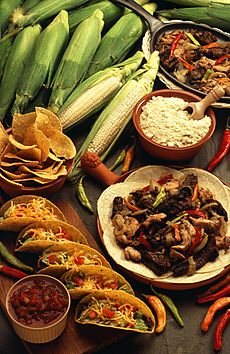
Hispanic food, especially Mexican food, has greatly influenced American eating habits. Mexican cuisine is now very popular in the U.S. Tortillas and salsa are almost as common as hamburger buns and ketchup. Tortilla chips sell more than potato chips. Plantain chips are also becoming more popular. The avocado is now a favorite fruit in America, especially among Hispanic Americans.
Because of the large Mexican-American population, the Southwest has some of the best Mexican food. Cubans brought Cuban cuisine to Miami. Today, snacks like cortaditos and pastelitos de guayaba are common there. Cuban culture has also changed Miami's coffee habits. A café con leche or cortadito is often enjoyed at coffee shops. The Cuban sandwich, created in Miami, is now a famous food in the city.
Notable Contributions
Hispanic Americans have made important contributions in many areas. These include politics, military, music, film, literature, sports, business, and science.
Arts and Entertainment
In 1995, the ALMA Award was created. It honors Hispanic performers in film, TV, and music. While there are many talented Hispanic artists, they are sometimes underrepresented in major awards.
Music Stars
Many Hispanic American musicians are world-famous. These include Jennifer Lopez, Selena Gomez, Pitbull, Gloria Estefan, Celia Cruz, Ricky Martin, Marc Anthony, Carlos Santana, Christina Aguilera, Bruno Mars, Mariah Carey, Cardi B, and Bad Bunny.
Music from Cuba (like chachachá and mambo) and Mexico (like ranchera and mariachi) was popular in the 1950s. Celia Cruz was a Cuban-American singer. She was one of the most popular Latin artists of the 20th century. She earned 23 gold albums.
Early rock and roll pioneers included Ritchie Valens (famous for "La Bamba") and Herman Santiago. Holiday songs like "¿Dónde Está Santa Claus?" and "Feliz Navidad" by José Feliciano are also popular.
In 1986, Billboard magazine started the Hot Latin Songs chart. It ranks top Spanish-language songs in the U.S. Later, they added the Top Latin Albums chart. The Recording Industry Association of America also gives "Gold and Platinum Awards" for Latin music.
The Lo Nuestro Awards started in 1989. They were the first awards for Spanish-language music. In 2000, the Latin Grammy Awards were created. They honor musicians who perform in Spanish and Portuguese.
Film, TV, and Theatre
Filmmakers like Edward James Olmos and Robert Rodriguez have shown the Hispanic American experience on screen. Actors like Hilary Swank, Michael Peña, Jessica Alba, and Jenna Ortega have become very successful. Films like La Bamba and Selena tell important stories.
Many Hispanic actors have achieved fame in Hollywood. From Puerto Rico: José Ferrer (first Hispanic to win an Academy Award), Rita Moreno, Jennifer Lopez, and Benicio del Toro. From Mexico: Anthony Quinn, Salma Hayek, and Danny Trejo. From Cuba: Andy García and Cameron Diaz. From the Dominican Republic: Zoe Saldana. Other notable actors include John Leguizamo (Colombian origin) and Pedro Pascal (Chilean origin).
In comedy, George Lopez, Gabriel Iglesias, and Carlos Mencia are well-known.
On TV, successful Hispanic actors include Desi Arnaz, Lynda Carter, Jimmy Smits, Eva Longoria, Sofía Vergara, Mario Lopez, and America Ferrera. Kenny Ortega is an Emmy Award-winning producer and director.
Organizations like the Hispanic Organization of Latin Actors (HOLA) work to increase Hispanic representation in media. In 1999, Hispanic groups protested the lack of Hispanic actors in new TV shows. This led to agreements with major networks to hire more Hispanic talent.
Business and Finance
In 2002, there were 1.6 million Hispanic-owned businesses. This number grew three times faster than the national average.
Important Hispanic business leaders include Roberto Goizueta, who led The Coca-Cola Company. Arte Moreno was the first Hispanic to own a major league sports team. He bought the Los Angeles Angels. Linda G. Alvarado co-owns the Colorado Rockies baseball team.
Some Hispanics are on the Forbes 400 list of richest Americans. These include Alejandro Santo Domingo and Jorge M. Perez.
Goya Foods is the largest Hispanic-owned food company in the U.S. Angel Ramos founded Telemundo, now the second-largest Spanish-language TV network. Samuel A. Ramirez Sr. was the first Hispanic to start a successful investment banking firm on Wall Street. Nina Tassler was president of CBS Entertainment.
Government and Politics
In 2007, over 5,000 elected officials in the U.S. were of Hispanic origin.
In the United States House of Representatives, many Hispanics have served. Current Hispanic senators include Bob Menendez, Ted Cruz, Marco Rubio, Catherine Cortez Masto, Ben Ray Luján, and Alex Padilla.
Hispanic governors include Nevada Governor Brian Sandoval and New Mexico Governor Michelle Lujan Grisham. Martinez was the first Hispanic woman governor in U.S. history.
Since 1988, when Lauro Cavazos became the first Hispanic United States Cabinet member, more Hispanics have served in presidential administrations. These include Ken Salazar, Hilda Solis, Alberto Gonzales, and Carlos Gutierrez. Rosa Rios was the U.S. Treasurer.
In 2009, Sonia Sotomayor became the first Hispanic Supreme Court Justice.
The Congressional Hispanic Caucus (CHC) and the Congressional Hispanic Conference (CHC) are groups that support policies important to Hispanic Americans. The CHC is made of Democrats, and the CHC is made of Republicans.
Groups like the United States Hispanic Leadership Institute (USHLI) work to help Hispanics. They promote education, leadership, and civic participation.
Military Service
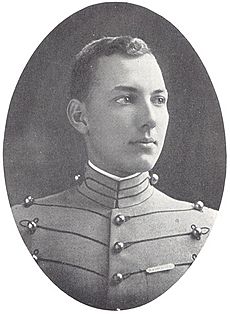
Hispanics have served in the U.S. military in every major conflict. Today, 11% to 13% of military personnel are Hispanic. They have served in the Iraq War and the Afghanistan War. Hispanics have shown bravery in battle and reached high ranks. So far, 43 Hispanics have received the Medal of Honor, the nation's highest military award.
Key Figures in Military History
- Bernardo de Gálvez (1700s): A Spanish military leader who helped the American colonies during the Revolutionary War.
- Admiral David Farragut (1800s): The first full admiral in the U.S. Navy.
- Brigadier General Diego Archuleta (1800s): The first Hispanic to become a brigadier general in the Union Army during the Civil War.
- Major General Luis R. Esteves (1900s): The first Hispanic to graduate from West Point in 1915.
- Lieutenant General Pedro del Valle (1900s): The first Hispanic to reach the rank of lieutenant general. He played a key role in World War II.
- Carmen Contreras-Bozak (1900s): The first Hispanic woman to serve in the U.S. Women's Army Corps during World War II.
- Admiral Horacio Rivero, Jr. (1900s): The second Hispanic four-star admiral. He commanded the fleet during the Cuban Missile Crisis.
- Sergeant First Class Jorge Otero Barreto (1900s): The most decorated Hispanic American soldier in the Vietnam War.
- Lieutenant General Richard E. Cavazos (1900s): The first Hispanic four-star general.
- Vice Admiral Antonia Novello (1900s): The first Hispanic (and first female) U.S. Surgeon General.
- Chief Master Sergeant Ramón Colón-López (2000s): The only Hispanic among the first six airmen to receive the Air Force Combat Action Medal.
Science and Technology
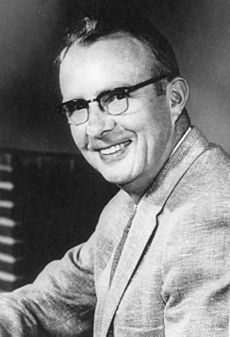

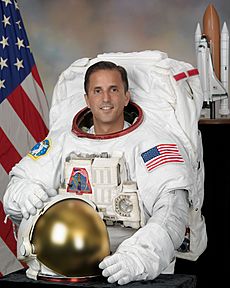
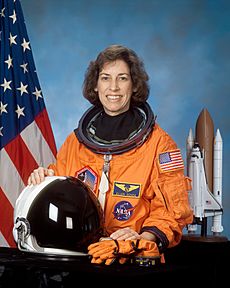
Many Hispanic Americans have excelled in science. Luis Walter Álvarez, a Nobel Prize-winning physicist, and his son Walter Alvarez, a geologist, suggested that an asteroid impact caused the extinction of dinosaurs. Mario J. Molina won the Nobel Prize in chemistry.
Dr. Victor Manuel Blanco discovered "Blanco 1," a galactic cluster, in 1959. F. J. Duarte is a laser physicist who invented the N-slit laser interferometer. Alfredo Quiñones-Hinojosa is a leading brain surgeon. Physicist Albert Baez helped develop X-ray microscopes. Francisco J. Ayala is a biologist and philosopher. Luis von Ahn founded Duolingo.
Dr. Fernando E. Rodríguez Vargas discovered the bacteria that cause dental cavities. Dr. Gualberto Ruaño is a pioneer in personalized medicine. Severo Ochoa, born in Spain, won a Nobel Prize in Medicine in 1959. Dr. Sarah Stewart discovered the Polyomavirus.
Several Hispanics have become NASA astronauts. Franklin Chang-Diaz is a record-holder for most space flights. Ellen Ochoa was the first Hispanic woman to go into space. Other astronauts include Joseph Acaba, José M. Hernández, and Michael López-Alegría.
Olga D. González-Sanabria helped develop batteries for the International Space Station. Mercedes Reaves designed a solar sail for NASA. Dr. Pedro Rodríguez invented a lift seat for people with knee arthritis.
Sports Achievements
Football Stars
Tom Flores was the first Hispanic head coach and quarterback in American professional football. He won Super Bowls as a player, assistant coach, and head coach. Anthony Múñoz is in the Pro Football Hall of Fame. Other successful Hispanic NFL players include Tony Gonzalez and Tony Romo.
Baseball Legends
Hispanics have played in Major League Baseball since 1873. Famous players include Ted Williams, Sammy Sosa, Alex Rodriguez, Roberto Clemente, Albert Pujols, and Mariano Rivera. Many Hispanic players are in the MLB Hall of Fame.
Basketball Greats
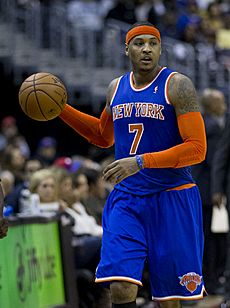
In basketball, players like Carmelo Anthony, Manu Ginóbili, and Pau Gasol are well-known. Dick Versace was the first Hispanic to coach an NBA team. Rebecca Lobo and Diana Taurasi are major stars in women's basketball.
Tennis and Soccer
Tennis players include Pancho Gonzales, Mary Joe Fernández, and Gigi Fernández. Monica Puig won a gold medal for Puerto Rico in 2016.
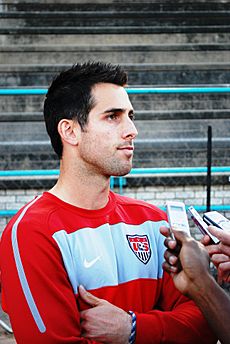
Soccer is very popular in the Spanish-speaking world. Hispanics have helped grow its popularity in the U.S. Many Major League Soccer teams have large Hispanic fanbases. Players like Tab Ramos, Claudio Reyna, and Carlos Bocanegra are famous.
Other Sports
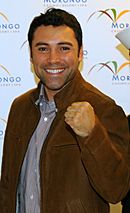
In boxing, champions include Oscar De La Hoya and Miguel Cotto. In mixed martial arts (UFC), fighters like Cain Velasquez and Tony Ferguson are well-known.
Bill Guerin was the first Hispanic player in the National Hockey League (NHL). Scott Gomez won the NHL Rookie of the Year Award in 1999.
Other notable Hispanic athletes include golfer Nancy López, softball player Lisa Fernández, and skateboarder Paul Rodríguez Jr.. Gymnast Laurie Hernandez won a gold medal in 2016.
See also
 In Spanish: Latinoamericanos e hispanos en Estados Unidos para niños
In Spanish: Latinoamericanos e hispanos en Estados Unidos para niños
- Hispanics
- Hispanidad
- Hispanics and Latinos in the American Civil War
- Hispanic and Latino Americans in World War II
- Black Hispanic Americans
- Hispanic and Latino American Muslims
- Latin America–United States relations
- List of Latin American Jews
- National Alliance for Hispanic Health
- Portugal–United States relations
- Spain–United States relations
- White Hispanic Americans
- List of U.S. place names of Spanish origin
- Demographics of the United States
- Historical racial and ethnic demographics of the United States
Images for kids
-
The Orchestra in Manhattan. New York City has a large Latino American population.
-
The Byzantine-Latino Quarter in Los Angeles. Hispanic Americans made up 48% of Los Angeles in 2020.
-
Storefronts at Lexington Avenue and 116th Street in East Harlem, also known as Spanish Harlem or "El Barrio".
-
The Church of Our Lady of Guadalupe in Little Spain, a key place for the Spanish community in New York for many years.
-
San Miguel Chapel, built in 1610 in Santa Fe, New Mexico, is the oldest church building in the United States.
-
Castillo de San Marcos in St. Augustine, Florida. Built in 1672 by the Spanish, it is the oldest stone fort in the United States.
-
Dolores Huerta in 2009. She has won many awards for helping workers and women. She was the first Hispanic in the National Women's Hall of Fame in 1993.
-
Proportion of Hispanic Americans in each county of the fifty states, Washington, D.C., and Puerto Rico as of the 2020 United States Census.
-
Intermediate level international-style Latin dancing at a competition.
-
Eva Longoria's family history suggests she may be a direct descendant of a Maya woman from Mexico.
-
Actress Alexis Bledel is a white Hispanic of Argentine and other European heritage. She grew up speaking Spanish.
-
Zoe Saldaña at the 82nd Academy Awards in 2010.
-
Lauro Cavazos, U.S. Secretary of Education from 1988 to 1990.
-
A mural on the side of the Westlake Theatre building showing Jaime Escalante and Edward James Olmos.
-
In 2007, University of Texas at El Paso was ranked the top graduate engineering school for Hispanics.


